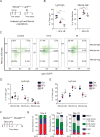Mex3a Marks a Slowly Dividing Subpopulation of Lgr5+ Intestinal Stem Cells
- PMID: 28285904
- PMCID: PMC5774992
- DOI: 10.1016/j.stem.2017.02.007
Mex3a Marks a Slowly Dividing Subpopulation of Lgr5+ Intestinal Stem Cells
Abstract
Highly proliferative Lgr5+ stem cells maintain the intestinal epithelium and are thought to be largely homogeneous. Although quiescent intestinal stem cell (ISC) populations have been described, the identity and features of such a population remain controversial. Here we report unanticipated heterogeneity within the Lgr5+ ISC pool. We found that expression of the RNA-binding protein Mex3a labels a slowly cycling subpopulation of Lgr5+ ISCs that contribute to all intestinal lineages with distinct kinetics. Single-cell transcriptome profiling revealed that Lgr5+ cells adopt two discrete states, one of which is defined by a Mex3a expression program and relatively low levels of proliferation genes. During homeostasis, Mex3a+ cells continually shift into the rapidly dividing, self-renewing ISC pool. Chemotherapy and radiation preferentially target rapidly dividing Lgr5+ cells but spare the Mex3a-high/Lgr5+ population, helping to promote regeneration of the intestinal epithelium following toxic insults. Thus, Mex3a defines a reserve-like ISC population within the Lgr5+ compartment.
Keywords: Lgr5+ ISC heterogeneity; chemotherapy resistance; quiescent stem cell.
Copyright © 2017 Elsevier Inc. All rights reserved.
Figures







References
-
- Barker N, Bartfeld S, Clevers H. Tissue-resident adult stem cell populations of rapidly self-renewing organs. Cell stem cell. 2010;7:656–670. - PubMed
-
- Barker N, van Es JH, Kuipers J, Kujala P, van den Born M, Cozijnsen M, Haegebarth A, Korving J, Begthel H, Peters PJ, et al. Identification of stem cells in small intestine and colon by marker gene Lgr5. Nature. 2007;449:1003–1007. - PubMed
-
- Batlle E, Henderson JT, Beghtel H, Van den Born M, Sancho E, Huls G, Meeldijk J, Robertson J, Van de Wetering M, Pawson T, et al. B-Catenin and TCF Mediate Cell Positioning in the Intestinal Epithelium by Controlling the Expression of EphB/EphrinB. Cell. 2002;111:251–263. - PubMed
-
- Buczacki SJA, Zecchini HI, Nicholson AM, Russell R, Vermeulen L, Kemp R, Winton DJ. Intestinal label-retaining cells are secretory precursors expressing Lgr5. Nature. 2013;495:65–69. - PubMed
-
- Buchet-Poyau K, Courchet J, Le Hir H, Seraphin B, Scoazec JY, Duret L, Domon-Dell C, Freund JN, Billaud M. Identification and characterization of human Mex-3 proteins, a novel family of evolutionarily conserved RNA-binding proteins differentially localized to processing bodies. Nucleic acids research. 2007;35:1289–1300. - PMC - PubMed
Publication types
MeSH terms
Substances
Grants and funding
LinkOut - more resources
Full Text Sources
Other Literature Sources
Medical
Molecular Biology Databases

